Well my current ride is a McVay Bluenose Sloop. This is an exchange that I started on the Sailnet forum about this great classic boat.
wrevans 11-16-2004 05:20 PM
Ok, how about a McVay Bluenose Sloop? Jeff_H, anyone?I am flat out amazed at the quality of information on this site and I have spent way too much time reading up on the old posts. Great resource for those of us just still on the steep part of the learning curve.
But after reading post after post, I am curious if anyone has any experience sailing my current boat, a McVay Bluenose Sloop. I admit that I fell in love with her lines and went through ridiculous hoops to get her to the San Juan Islands. Then she spent 2 years on the hard while I built a house. Ah, but March 1st will be a different story. So I would love to know if anyone has any experiences or tips that they could pass along. How do they sail? Do they have any bad habits? Just looking for a bit of juicy info to help the winter go faster. Thanks Bill
Jeff_H 11-17-2004 02:39 AM
Ok, how about a McVay Bluenose Sloop? Jeff_H, anyone?I have never sailed the McVay Bluenose sloops and I am not even sure that I have been aboard one except perhaps at a boatshow many years ago. I know very little that is specific to them.
From what I recall they were designed as one design raceboats with an eye to a rating rule that proceeded the CCA rule, and so are probably Universal Rule boats. Raceboats of that era were even more extreme than the CCA era boats, with extremely narrow beam, low freeboard and extremely short waterline length. It produced boats that were beautiful to look at, challenging to race, but not very good sailing boats in an absolute sense.
Like most race boats of that era they were small fraction (2/3 or 3/4 vs 7/8), fractional rigs. This made them tactical and easier to handle in the days before geared winches were common.
While I have never sailed a Bluenose, I have raced and sailed on similar boats (Luder 16''s, Etchells, Westphalls [sp], Resolutes, Dragons, and IOD''s). These were challenging boats to sail well.
In a general sense the extremely short waterline coupled with the very narrow beam found on boats like these was a real handicap to their sailing ability. They were very tender and required a lot of sailing skill to keep at a reasonable angle of heel.
Their sail plans are fairly small and so they were not very good light air boats. They were a real challenge in heavy air. I do not know how the Bluenose cockpit and deck is laid out but on most of the boats of that era, it was pretty easy to take a hard knock down in a gust and swamp them, or even sink them.
Boats of that type were really aimed at flat water sailing. In a chop, the short waterline length meant that they would hobby-horse to a near stop and even in a longer chop, with their low freeboard they would tend to take a lot of water over the deck and would ship a lot of green water in the cockpits.
Boats like these thrived on heavy crews hiking out ''tooth and toenail''. In heavier conditions the ability to hike became a matter of survival as a knock down could swamp the huge cockpits of the day and the comparatively tiny cockpit drains really were not up to the task of draining the boats.
Still and all, the challenges of sailing boats like these well was very rewarding. It was in fact the challenges of sailing these boats that make them so interesting to folks like me. There was a whole different aesthetic to sailing boats like these and to this day, I think that they are fun to mess with and gorgeous to look at.
Respectfully,
Jeff
mikehoyt 11-17-2004 03:34 AM
Ok, how about a McVay Bluenose Sloop? Jeff_H, anyone?Bill
There is actually a weatlth of information available online about the Bluenose sloop. Check out http://www.cs.ubc.ca/spider/flinn/bluenose/sloop/sloop.html
This boat was originally created in Nova Scotia as a one-design class for the Armdale Yacht Club in Halifax. As the story goes a group of members approached William Roue who designed the Grand Banks fishing schooner Bluenose (the one on the Canadian dime that won every race)to design a boat for racing at AYC.
You will note on the web site mentioned above that the boats were originally built of wood and then McVAy Yachts of Mahone Bay, NS made a number out of fibreglass. The wooden boats are reputed to be faster.
There have recently been at least 2 wooden Bluenoses built (one was on display in Casino Nova Scotia in Halifax for a year) but the cost of a new wooden version is astounding (I think it was selling on Yachtworld for $53000 Cdn).
Herring Cove Marine outside of Halifax is currently manufacturing fibreglass versions but has modified the keel weight distribution (not shape) over the original McVay ones. It is reputed to be faster but is still in the neighbourhood of $28,000 Cdn new. He is not making large numbers. Herring Cove Marine also refurbishes older Bluenoses.
These boats still race in Halifax and Mahone Bay areas. A McVay version just sold from our club on the North Shore of Nova Scotia and the rumour is the new owner is planing on spending tens of thousands fixing it up to race.
Armdale Yacht Club is located on the Northwest Arm off Halifax Harbour. The area is very protected (except in Hurricane Juan last year) and the waters are flat but the winds very shifty. This boat is ideal for these conditions. Our club (BHYC in Tatamagouche Bay (Amet Sound) NS) is sometimes flat and sometimes wavy with choppy waves due to the shallow warm water (< 3 feet). In close together 2 - 3 foot swells the Bluenose is VERY WET and not for a lazy sailor. It does not race well in these conditions but does well in flat water as Jeff suggested.
A smaller sister to the Bluenose was the Minuette made also by McVay in Mahone Bay. Where the Bluenose was 23'' LOA the Minuette was 19'' LOA. Although it looks very similar to the Bluenose Sloop the Minuette was much slower. However it did sail quite similarly. In the late 70''s - early 80''s my familay owned a Minuette which I aptly named Full Tilt. It came with a working jib and a genoa as well as a spinnaker and main. Our boat was also kept on the Northwest Arm in Halifax less than one mile from the Armdale Yacht Club. The boat was easily sailed by two and a LOT of Fun! Our favourite trick was to sheet everything in tight (using Genoa) and put the boat beam to the wind. The boat would heel so far that the water was unbroken until it hit the cockpit floor. The leeward rail, seat and all was beneath the surface. The boat would hold in this position as the hull deflected the wind over the sails. As I said .. A LOT OF FUN! I am assuming that in the wrong conditions this could easily lead to the sinking of the boat. Note that the Victoria 18 is believed to be made from a Minuette mold.
The Minuette and the Bluenose sloops are wet and open boats. They are a far different experience than the larger keelboats with cabins and in my opinion more fun in many many ways. I would send my kids sailing in one unattended in a heartbeat as they are well built and good for harbour/Bay sailing.
Regards Mike
on Full Tilt 2
Niagara 26
Halifax, Nova Scotia
(OK .. so I am not actually on the boat today)
wrevans 11-17-2004 12:05 PM
Ok, how about a McVay Bluenose Sloop? Jeff_H, anyone?Jeff & Mike,
Thanks for the very detailed and thoughtful replies. Ah the consciences of chasing beautiful women. It is very helpful to have a feeling of what to expect next spring when I sail her for the first time. I appreciate the warnings of potential swamping and sinking and your advice makes sense as the Bluenose has a huge cockpit and rather small drains. I will keep the drop board in place and be careful.
Jeff, what do you consider and adequate sail plane for light air performance? In reading you previous posts I received the impression that you favored fractional rigs. The Bluenose carries about 216 square feet of sail area with the blade working jib and 253 square feet with the Genoa. This on a displacement of 2,050 lbs including 900 pounds of ballast. This translates to an SA/D of 21 & 25 respectively. Are you saying that for its type (modified full keel) its sail are is not adequate for light air?
I have sailed on other peoples boats on and off for many years and I am looking forward to finally having a boat of my own. So right or wrong this old gal will be my teacher. I am a bit anxious but at the same time excited and giddy.
Thanks,
Bill
john gov 11-17-2004 02:44 PM
Ok, how about a McVay Bluenose Sloop? Jeff_H, anyone?Looking at the Bluenose I''m wondering how it compares to the Pearson Ensign. The Ensign looks to have a longer waterline, otherwise their "appearance" looks similiar.
How do the rigs compare?
just curious Thank you, John Gov.
gstraub 11-17-2004 03:03 PM
Ok, how about a McVay Bluenose Sloop? Jeff_H, anyone?Don''t really know much about them, but a dock neighbor of mine had one and I always drooled over it. Looks like a great boat.
Gerhard
Jeff_H 11-17-2004 03:06 PM
Ok, how about a McVay Bluenose Sloop? Jeff_H, anyone?By normal conventions SA/D is cited for a boat with its 100% foretriangle so the SA/D for your boat would be something near the 21 with the the jib rather than genoa. A SA/D somewhere above 21 should yield a reasonably good light air performance.
As I mentioned I have not sailed a Bluenose and was basing my comments on similar boats and their lighter air performance. Normally these narrow, short waterline, low freeboard boats of that era were not able to carry much sail area without being overpowered in higher winds. An SA/D of 21 sounds like a lot of sail for a boat that narrow.
One thing about some of these older designs they sometimes have surprisingly little wetted surface compared to a boat like a J-24 which is beamy, comparatively flat bottom. If that is the case with the Bluenose, given its comparatively large sailplan for the type, it might actually have good light air performance, perhaps at the price of being a real handful in heavier going.
In any event, the proof will be in the pudding.
Jeff
wrevans 11-17-2004 03:50 PM
Ok, how about a McVay Bluenose Sloop? Jeff_H, anyone?Jeff,
Well high SA/D or low wetted surface aside, with a PHRF rating of 264 it would get spanked by either a J22 or a J24 with their rating in the 170’s. It is hard to argue your convincing descriptions of the improvements of modern sailboats.
Jeff, one more question if you don’t mind. I have read that the theory used to be that boats with large overhangs increased their waterline length as they heeled thus increasing their potential hull speed. Going downwind they had a smaller waterline and less wetted surface. I have since read that this never really worked since they added additional wetted surface (and drag) when heeled. Were large overhangs just a result of the racing rules at the time? I would appreciate one of you “just the facts Mam” discussions on overhangs and hull speed.
Thanks again,
Bill
Jeff_H 11-17-2004 06:00 PM
Ok, how about a McVay Bluenose Sloop? Jeff_H, anyone?"Just the facts, Mam", I like that. I have seen a lot of discussion on this and it really is not cut and dry.
As you are aware at the core of it the long overhangs were intended to trick the rule into thinking that the boat was slower than it really is. Since the boats were measured upright and static the short waterlines looked really slow. When the heeled the bow wave moved forward and in fact did give more speed than the rule would predict. There was less gain in the area of the run. As a boat approaches hullspeed the stern begins to squat. The long overhangs not only did not prevent squatting but actually contributed to it without providing enough lift to offset the downward rotation. So while the stern wave moved slightly aft, the achieveable speeds were nowhere near what should have been achievable with the predicted hullspeed for a waterline length equal to the heeled waterline lengths of these boats.
In other words, while these boats were faster than the rule would predict, they still gave away a lot of performance compared to a more wholesome design with an equal length waterline to their sailing waterlines and when things got lumpy, the longer waterlined boats were a lot more comfortable and were not as adversely affected by the conditions.
Rules like the CCA and the earlier International and Universal rules generally promoted boats that were an aberation from what was considered good design practice before these rules and were certainly poor boats compared to what followed. They were designs that ignored seaworthiness and seakindliness just to beat the rule.
Respectfully,
Jeff
Silmaril 11-18-2004 03:27 AM
Ok, how about a McVay Bluenose Sloop? Jeff_H, anyone?OK... I have not sailed on a Bluenose, but was following the thread regarding the discussion on S/D ratios, designs, etc. I really enjoy the discussions here.
I took a look at the only pic of a Bluenose I could find, and it reminded me of an Ensign, which I found to be a nice sailing boat.
But following up on the design portion of the discussion, I was wondering how the Atlantic Class boats were able to sidestep much of the issues that were brought up. They have a realitively fast projected PHRF of 170, sail well in light air, moderate breeze, and I have been out in 30kts in them. It was rough, but then 30kts in a J24 is no treat either. No, it is not offshore capable, and no overnight capabilities either. But I have always been amazed at their speed, grace, and all round sailing abilities.
Long, narrow, low freeboard, huge overhangs, keel hung rudders, no engine. But here they are, an over 75 year old design, still in production and actively sailed and raced.
I would assume that this means that to every set of "rules" there MAY be exceptions. Sometimes not, but by putting all "types" into the same basket, you may pass up on a gem.
Jeff_H 11-18-2004 10:05 AM
Ok, how about a McVay Bluenose Sloop? Jeff_H, anyone?Ah now you have hit upon a couple of my real favorite topics. I must admit at the ''gitgo'' that I have a tremendous prejudice towards the work of Starling Burgess, who, of course was the designer of Atlantic. I consider Burgess to be one of the great designers of all time. In so many ways he was a real renaissance man creating new ideas in so many fields of endeavor. He is perhaps only rivaled for pure creative genius by someone like Nat Herreshoff. The Atlantic really is an extremely clever design. The knuckle bow really allowed a very flat entry angle and the fairly flat counter allowed a very flat run. These like the Herreschoff S boats would have been rule beaters in the extreme offering much better performance than the rules of their day would have predicted. Proportionately, Atlantics actually had fairly short overhangs compared to some of their contemporaries such as the Resolutes or Luders 16''s.
That said, in an absolute sense, the Atlantic is a pretty long boat (a tick over 30 feet if I remember correctly) for a rating of 171. While I could not find a PHRF rating for the Atlantic, if it does have a PHRF rating of 171 that would not be all that fast a rating for a 30 compared to a J-24 for example which is 6 feet shorter, sailing on a substantially shorter waterline and is only rated 3-6 seconds a mile slower.
Respectfully,
Jeff
wrevans 08-22-2005 09:48 PM
Ok, how about a McVay Bluenose Sloop? Jeff_H, anyone?I thought I would add a few thoughts to this thread now that I have launched and sailed (almost obsessively) my Bluenose Sloop.
My first impression is that this boat is a blast to sail. I have no where near the experience Jeff_H has so this is completely subjective. But I have been sailing alone and with a friend without an engine and have enjoyed this little boat. I don’t have any instrumentation but I am guessing (actually I check the ferry reports for my sailing area) that my winds have been 10-20 knots with a boat speed of between 5 & 7 knots.
The downside of fractional rigs:
I searched far and wide for a boat with fractional rigging for many of the reasons Jeff states but mostly to keep sail control aft of the mast. This boat does exactly that (or it will when I rig the reefing gear). The downside however is that you can’t easily add additional sail area. My Bluenose has a great SA/D ratio but since I sail without an engine light air performance for me is 1 to 4 knots. With the fractional rig with jumper stay it is painful to add a large drifter or asym (although I am going to try).
Modern verse traditional (ok old) designs:
I sometimes wondered when I read these boards about the merits of old versus new designs if this argument is like those in other industries. Anyone could argue that the computer I am typing this on is not worth turning on anymore. I think in the end we buy the type of boat that draws us to it. In my case this little “Universal Rule” Bluenose sloop gets me out on the water and brings me back smiling.
Bill
Lopez Island, WA
dman 08-23-2005 04:29 AM
Ok, how about a McVay Bluenose Sloop? Jeff_H, anyone?Quote" My first impression is that this boat is a blast to sail. I have no where near the experience Jeff_H has so this is completely subjective. But I have been sailing alone and with a friend without an engine and have enjoyed this little boat." end quote This is where you are wrong my friend you have more experience with this boat because you are one of the few who has had the pleasure of sailing these boats.There is theory and then there is reality,sometimes they are the same ,other times they are not.The seat of the pants test is the best indicator of what works for you.Having a solid modest boat that fits your needs is great.There are too many people out there that depend on the bank loans to get out on the water.Going in debt for a pleasure craft can be the worst experience in boating.Good luck to you and remmeber you are now the "expert" when it comes to these boats.
rmohr 09-21-2005 07:47 PM
Ok, how about a McVay Bluenose Sloop? Jeff_H, anyone?Bill,
I just purchased a McVay Bluenose Sloop that I finally found in Vancouver, BC. I first saw "B1" at the Halifax Maritime Museum 5 years ago and it was love at first sight. My boat is currently being restored over the winter and I will be taking it home to Kelowna, BC next season, where it will live in the fresh water of Lake Okanagan.
I read your message on the sailnet board and would greatly appreciate any feedback or advice you may have. I do not know much about the boat''s history other than it has been in the Vancouver area for 10 years and sails under the name "Ragtime". I do not know the sail# - My sail only has a "B" on it. Can you tell me how your sail # relates to the Hull# on the plaque? I am excited about sailing this particular boat and was very happy to hear about your experience. I look forward to any assitance you might provide. Thanks again.
Bob
gstraub 09-22-2005 04:10 PM
Ok, how about a McVay Bluenose Sloop? Jeff_H, anyone?I don''t know anything about these boats except that a dock neighbor had one and I always admired it. Congratulations on the new boat.
Gerhard








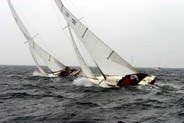



+Luders.jpg)


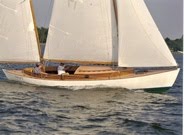
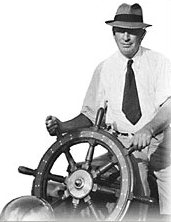

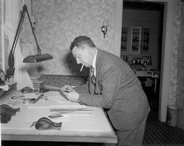
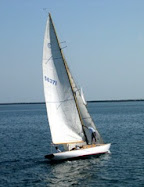



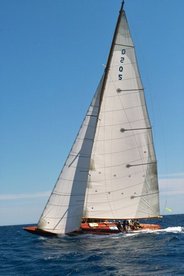






8 comments:
Gents,
Thanks to good fortune and grace,my family and I are McVay Bluenose owners.B193. I read your Blog and was both amused and enlightened
So far as hull performance you would enjoy knowing that my brother a seasoned racer of j and Olson monohulls of recent vintage was racing with me aboard Whisper. On the first beat of a club race he chided me for letting her heal until he saw the ground we made up. That waterline increase while healing really does impact her speed and is aestheticallly speaking beautiful to behold. .
Your McVay
is a treasure to those who love the beauty of sail. The boats are rigged with spinnakers and some are also rigged with genoas that could increase off the wind performance so as a purist, I would dissuade you from an asymetrical chute. There are stresses that this gear could place on your rig that are not contemplated in Roue's design that could have disasterous consequences.
Reefing the main on your bluenose will dramatically improve heavy air performance. I have comfortably sailed in 25 to 30 knots and so long as the heal is controlled with the sheet and traveler, the balance of the helm is delightful. So REEF if you are seeing or expecting whitecaps without fail.
I do not think these boats need a motor. We sail off a mooring and again the purist in me thrives on launching and returning under sail. Whisper formerly True North was so named for her agility in light air. Of all man made objects of desire, the most coveted of these flawlessly blend beauty with function.
The 1987 Porsche 911 carrerra coupe is one example.
The McVay Bluenose is another. . .
Enjoy!
AT
Thanks for your comments about the Bluenose sloop. I no longer have mine as I have upgraded to my "new to me" custom Shields "Knockabout". I very much enjoyed the three years that I sailed the Bluenose and was a bit worried that the Shields wouldn't be able to fill her shoes. Fortunately that wasn't the case. But I will always have great memories for the Bluenose.
Happy sailing, Bill
I truly appreciate the information found in your comments and advice. I recently became the owner of a Bluenose and am finding inspiration from sites like this.
Regarding the "Motor" question...I find beauty in the lack of a motor, in its simplicity, but I do admit that I recently purchased a electric motor for convenience and ease of use.
The question for me was convenience versus simplicity. I guess that I choose convenience.
Regards,
B.T. Quissy
B. T. Quissy,
In spite of my passionate writing on sailing without an engine, there are not right or wrong choices here. Many see my passion as judgment but that just isn't the case.
The Bluenose is a great little "big" sailboat. Mine took care of me very, very well as I reacquainted myself with sailing. In fact, they are such great sailing boats that when you learn to sail her well and know your winds and tides her sails alone will bring you home at your convenience.
Cheers and enjoy, Bill
My Brother an I just purchased a McVay Bluenose for 700.00 - it's in solid shape, rigging, hull, keel, sails all seem good to go- Cosmetically the hull, above the water line is old, a few scuffs and faded light blue. Could use a gel coat and bottom paint. We are getting the bottom cleaned of alge and hope to take her out for a maiden voyage very soon. My question to all concerned is how do these boats sail off the West Coast - we live in LA and the waters off Maria Del Rey are calm but have a pretty constant swell. Any advise, info etc would be greatly appreciated - Also any quess-timate on cost to repaint and gel coat the bottom and hull - all that said it has been love at first sight for us and can't wait to sail her.
I sailed one of these out of Marina del Rey on a very brisk day. Tacking into the wind we passed everyone on our way out the channel. It was one of the best days of sailing I ever had. It's the perfect size for fun.
Ollie
My wife and I purchased a very used McVay Bluenose last summer in Vancouver, BC and trailered it home to Sammamish, Washington. I have been cleaning the boat up and replacing worn out deck gear. We will spend the winter painting the hull and getting the rigging renewed so we are ready to sail next spring. The kind folks we bought the boat from did take us for a afternoon sail on the Puget Sound just outside of Vancouver on a very blustery day with full main and genoa. They actually had little sailing experience having received the boat originally to cover a bad debt so were a bit over their head for this kind of a windy day. Let's just say this was a real confidence building day for my wife and I as there were whitecaps everywhere in a heavy chop and we were very overpowered. But this little (big) boat really handled well under the circumstances particulary if you did not mind having the leeward rail underwater a lot and actively minded the mainsheet and tiller. I feel like she would have been a real gas to sail in that 15-20 knot wind with just the jib and reefed main (the main has no reef points currently but it will get a set this winter). So, as we refresh and upgrade, any suggestions and or sail handling advice would be greatly appreciated. Thanks!
Steve,
I would be glad to answer any questions you may have about the Bluenose and share my experiences. If you would drop me an email, envelope icon upper left, I will send you my phone number and we can chat. Might be easier than typing on my iPad.
Cheers,
Bill
Post a Comment